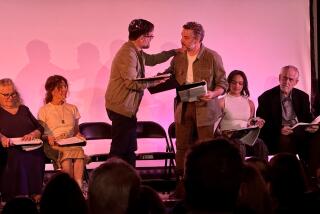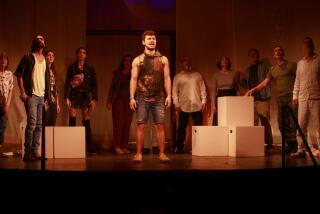Art, Politics and Dissent in Sweeping ‘Pentecost’
David Edgar’s “Pentecost” was first produced in 1994, before the events of Sept. 11 had so radically reconfigured the world political landscape. A certain anachronistic mustiness is evident in the play’s current production at the Evidence Room. However, that and the play’s other shortcomings are dwarfed by the sheer scope of director Bart DeLorenzo’s sweeping, magnificently designed staging, an accomplishment that expands the potential of 99-seat theater.
Challenging, convoluted and at times blatantly self-indulgent, the play is set in an abandoned church in an unnamed Eastern European country shortly after the fall of the Berlin Wall. A 13th-century fresco--hidden, ironically, behind a wall emblazoned with a revolutionary Communist painting--has just been discovered. If proved to predate the works of Giotto, as suspected, the crucifixion scene could explode accepted notions about European art, not to mention trigger a lucrative tourist boom.
The first half of the play concerns whether or not the painting is authentic, and whether it should be stripped from the wall and removed to the country’s national museum. The simple premise spurs a prolonged and provocative discussion that ranges from the fallacy of cultural relativism to the increasing disillusionment of Eastern European society in the post-Soviet order.
Frustratingly, Edgar’s intellectual cerebration turns hemorrhagic when a dozen or so armed and desperate refugees barricade themselves inside the church, taking hostage the Western art experts inside. A polyglot mix, the refugees, who range in ethnicity from Sri Lankan to Kurd to Bosnian, are a remarkably egalitarian group presided over by a female Palestinian, whose absolute authority the men accept without a murmur. Granted, the refugees are subtly sliding into dissent by the play’s final cataclysm. That is to Edgar’s credit, as is his prescient grasp of the destabilization soon to follow the Soviet fall, including the dispiriting surge of nationalism and ethnic hatred. But Edgar, a dedicated leftist perhaps best known for his Tony-winning adaptation of “Nicholas Nickleby,” reduces his multiethnic assemblage to polemical exponents, stridently decrying the big, bad West for the ills of the world.
Still, Edgar knows his way around an epic. In fact, “Pentecost” is part of a trilogy of plays inspired by Edgar’s travels to Eastern Europe both before and immediately after the Soviet collapse. For Lorenzo and company to even assay a project of this magnitude is remarkably gutsy. Only once does Lorenzo’s staging falter, in a painfully leisurely sequence evidently meant to induce a trance-like, tribal atmosphere, especially excessive considering the play’s three-hour-plus running time.
With only rare blunders, a large and ardent cast manages to hold our interest throughout. The design components--especially Jason Adams’ set, Lap-Chi Chu’s lighting, and John Zalewski’s sound--are world-class by any standards.
As for the play, it holds no easy answers and little hope for a brighter tomorrow. But whether you agree with Edgar’s passionate denunciation--or indeed, can even make sense of it--there’s no doubt that you will leave the theater continuing the discussion.
“Pentecost,” the Evidence Room, 2220 Beverly Blvd., L.A. Thursdays-Sundays, 8 p.m. Ends July 7. $15-$20. (213) 381-7118. Running time, 3 hours, 25 minutes.
More to Read
The biggest entertainment stories
Get our big stories about Hollywood, film, television, music, arts, culture and more right in your inbox as soon as they publish.
You may occasionally receive promotional content from the Los Angeles Times.










